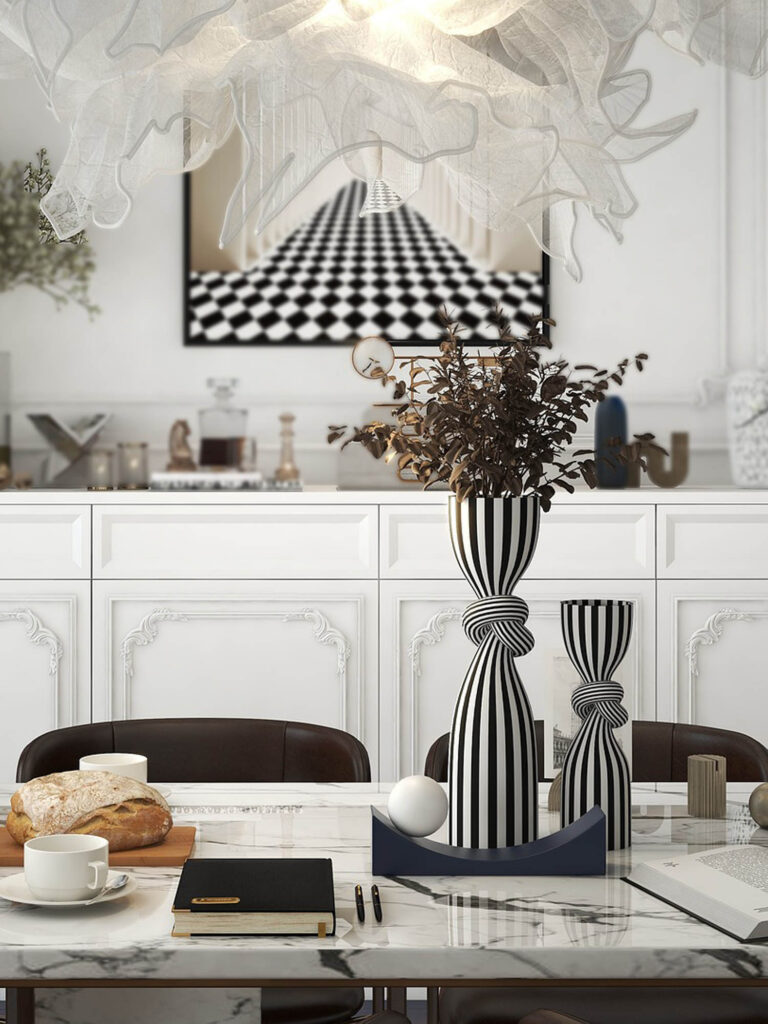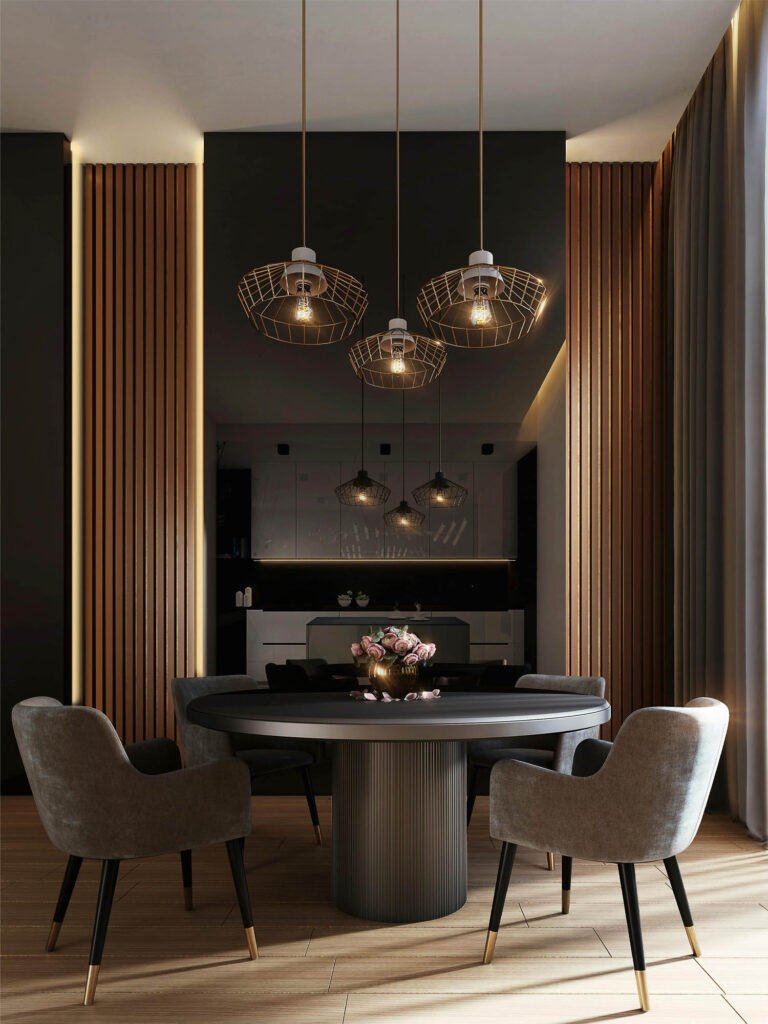The dining room is more than just a place to eat; it’s where memories are made, stories are shared, and celebrations unfold. From intimate family dinners to extravagant holiday feasts, every big and small event of your life will likely happen in your dining room. Therefore, it’s essential to create a space that not only accommodates your needs but also elevates every meal into a special occasion.

Round Tables vs. Rectangle vs. Square Tables: Finding the Right Shape
When it comes to selecting the ideal dining table, it’s crucial to weigh the advantages and drawbacks of different shapes. Round tables are renowned for fostering lively conversations and are particularly suitable for intimate gatherings or smaller spaces. Their circular design encourages face-to-face interaction among diners, ensuring that everyone feels included in the conversation.
Additionally, their lack of sharp corners allows for seamless movement around the table, making them space-efficient and versatile in various room layouts.
On the other hand, rectangular tables exude a sense of tradition and elegance, making them a classic choice for larger gatherings and formal occasions. With their elongated shape, these tables offer ample seating capacity, accommodating numerous guests comfortably. They provide a generous surface area for serving dishes, facilitating communal dining experiences and multi-course meals.
Moreover, their versatility in placement—whether against a wall or at the center of the room—allows for flexible arrangement options to suit different spatial constraints and event dynamics.
Meanwhile, square tables epitomize contemporary design aesthetics and are favored for their sleek and modern appearance. Their clean lines and compact footprint make them well-suited for urban dwellings or minimalist interiors. Despite their smaller size, square tables efficiently utilize space, making them ideal for cozy dining areas or compact rooms. While they may not promote group conversations as effectively as round tables, square tables create an intimate setting conducive to close interactions among a few individuals, perfect for quiet dinners or small gatherings.
The choice between round, rectangular, and square tables ultimately depends on your specific preferences, space constraints, and intended use. Whether you prioritize conversation facilitation, seating capacity, or aesthetic appeal, each table shape offers its own unique advantages, allowing you to create a dining space that suits your needs and enhances your overall dining experience.
Rug or No Rug? Adding Texture and Comfort
Whether to place a rug under the dining table is a common dilemma. While a rug can add warmth, texture, and definition to the dining area, it can also be a magnet for spills and stains. Opt for a durable rug made from easy-to-clean materials, and ensure it’s large enough to accommodate the chairs even when pulled out.
Dining Room Chandeliers and Lighting: Setting the Mood
The right lighting can indeed elevate the ambiance of your dining room, turning it into a captivating space that enhances your dining experience. When selecting a chandelier, it’s essential to choose one that complements the style and scale of your room. A general rule of thumb for hanging a chandelier over a dining table is to ensure that it hangs approximately 30 to 36 inches above the tabletop surface. This height allows the fixture to illuminate the table adequately without obstructing the view or overpowering the space.
For rooms with higher ceilings, you may need to adjust the hanging height accordingly to maintain proper proportions. In such cases, consider suspending the chandelier slightly higher while still ensuring that it effectively illuminates the dining area below. Additionally, take into account the size and shape of your dining table when determining the appropriate placement of the chandelier. Ideally, the fixture should be centered over the table to create a balanced and visually appealing focal point.
Incorporating dimmers into your lighting design is another essential consideration for enhancing the ambiance of your dining room. Dimmer switches allow you to adjust the intensity of the lighting, enabling you to set the mood according to the occasion. Whether you’re hosting a formal dinner party or enjoying a cozy meal with family, dimmable lighting provides the flexibility to create the desired atmosphere. By dimming the lights, you can create a warm and inviting ambiance that encourages relaxation and intimacy, perfect for intimate gatherings or romantic dinners.
What the Dining Room Needs to Be: Creating a Welcoming Atmosphere
A well-designed dining room should be both functional and inviting. Incorporate elements like artwork, mirrors, or a sideboard to add personality and charm. Ensure there’s ample seating for guests, including comfortable chairs and host/hostess chairs that command attention at the head of the table.
Discover the art of elevating every meal by delving into the enchanting realm of the dining room as a space for celebration—keep reading to unlock the secrets of culinary delight and festivity!
Getting Started: Planning Your Dining Room Design
Begin by assessing your space and identifying your priorities. Determine the size of the table based on the room dimensions and the number of people you plan to accommodate regularly. Experiment with different layouts to find the most functional arrangement, keeping in mind traffic flow and ease of access.

Wallpaper and Paint: Adding Color and Pattern
Injecting personality into your dining room can be achieved through the strategic use of wallpaper or paint. Both options offer distinct ways to introduce color, pattern, and texture, allowing you to customize the space to reflect your unique style and preferences.
Wallpaper presents an opportunity to infuse your dining room with bold hues and intricate patterns that make a statement. Vibrant colors like deep blues, rich greens, or fiery reds can create a dramatic backdrop, while patterns such as florals, geometric shapes, or abstract designs add depth and visual interest to the walls, becoming a focal point of the room.
Choosing wallpaper with personality and character can imbue the dining room with a sense of style and individuality. Whether it’s a vintage-inspired floral print, a contemporary geometric pattern, or a whimsical motif, the wallpaper sets the tone for the entire space, reflecting your unique aesthetic sensibilities.
Wallpaper can be used to cover an entire wall for maximum impact or to create an accent wall that highlights a specific area of the room. An accent wall featuring bold wallpaper can serve as a captivating backdrop for a dining table or a display of artwork, adding visual intrigue without overwhelming the space.
For a more understated approach, neutral tones provide a timeless backdrop for your dining room decor. Shades of white, beige, gray, or taupe create a versatile canvas that allows other elements in the room to take center stage. Neutral walls provide a sense of serenity and sophistication, making them an excellent choice for those who prefer a classic and refined aesthetic.
Paint offers endless possibilities in terms of color selection, allowing you to tailor the palette to suit your desired atmosphere and mood. Whether you opt for soft pastels, earthy tones, or bold jewel tones, the paint color significantly influences the overall ambiance of the dining room. Experimenting with different shades and finishes, from matte to glossy or textured effects, can help achieve the desired look.
Painting your dining room walls provides an opportunity for customization and personalization. You have complete control over the color scheme and application technique, enabling you to create unique effects such as ombre, color blocking, or faux finishes. Additionally, painting architectural details like trim, moldings, or ceiling beams can enhance the room’s architectural features and add visual interest.
Setting it Apart: Making Your Dining Room Stand Out
Differentiate your dining room from the kitchen by incorporating distinct design elements. While cohesion between spaces is essential, adding unique features like statement lighting, accent furniture, or decorative accessories can help your dining area make a statement of its own.
In conclusion, the dining room holds a special place in our homes as a hub for connection and celebration. By carefully considering the layout, furniture, lighting, and decor, you can create a space that not only caters to your practical needs but also elevates every meal into a memorable experience.
Whether it’s a casual brunch with friends or a formal dinner party, your dining room should be a reflection of your personal style and a welcoming environment for cherished moments to unfold.
Happy Celebrating!




